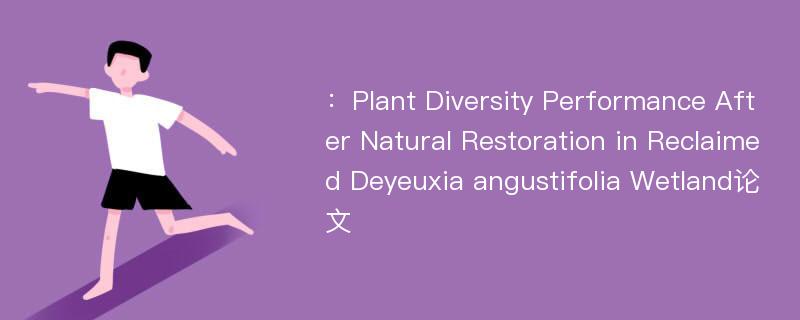
本文主要研究内容
作者(2019)在《Plant Diversity Performance After Natural Restoration in Reclaimed Deyeuxia angustifolia Wetland》一文中研究指出:Deyeuxia angustifolia wetlands were widely distributed in the Sanjiang Plain in Northeast China. Due to strong demand for food production, large-area wetlands were reclaimed to farmlands, which threatened regional ecological security greatly. Since the 21 th century, returning farmlands to wetlands was widely adopted for natural restoration in the Sangjiang Plain. As the first reflection of wetland restoration, vegetation succession of restored D. angustifolia wetlands should be fully assessed. In this study, vegetation investigation was carried out in three restored D. angustifolia wetlands with 5, 8 and 12 yr restoration, respectively. Meanwhile, a natural D. angustifolia wetland was selected as reference wetland. Results showed that community composition changed greatly and there was visible community succession. Community dominant species changed from composite to gramineae as restoration time increasing.At first, weeds community appeared in the restored wetlands, especially the xerophytes developed to the pioneer species rapidly. And then, mesophytes and wetland species became the dominant species in the restored wetlands. Finally, wetland species, especially D. angustifolia, occupied the dominant position of restored community. Shannon-wiener index(H) and Simpson index(D) both decreased to close to natural D. angustifolia wetlands. Compared with natural D. angustifolia wetland, species composition and diversity in restored wetlands were more complex and higher. As restoration time increasing, there were not significant differences between community characteristics of restored wetlands and natural wetland. All these suggested that vegetation in reclaimed D. angustifolia wetland could be restored naturally, but its restored period is 10 yr at least. From another angle, it is important to protect current natural wetlands.
Abstract
Deyeuxia angustifolia wetlands were widely distributed in the Sanjiang Plain in Northeast China. Due to strong demand for food production, large-area wetlands were reclaimed to farmlands, which threatened regional ecological security greatly. Since the 21 th century, returning farmlands to wetlands was widely adopted for natural restoration in the Sangjiang Plain. As the first reflection of wetland restoration, vegetation succession of restored D. angustifolia wetlands should be fully assessed. In this study, vegetation investigation was carried out in three restored D. angustifolia wetlands with 5, 8 and 12 yr restoration, respectively. Meanwhile, a natural D. angustifolia wetland was selected as reference wetland. Results showed that community composition changed greatly and there was visible community succession. Community dominant species changed from composite to gramineae as restoration time increasing.At first, weeds community appeared in the restored wetlands, especially the xerophytes developed to the pioneer species rapidly. And then, mesophytes and wetland species became the dominant species in the restored wetlands. Finally, wetland species, especially D. angustifolia, occupied the dominant position of restored community. Shannon-wiener index(H) and Simpson index(D) both decreased to close to natural D. angustifolia wetlands. Compared with natural D. angustifolia wetland, species composition and diversity in restored wetlands were more complex and higher. As restoration time increasing, there were not significant differences between community characteristics of restored wetlands and natural wetland. All these suggested that vegetation in reclaimed D. angustifolia wetland could be restored naturally, but its restored period is 10 yr at least. From another angle, it is important to protect current natural wetlands.
论文参考文献
论文详细介绍
论文作者分别是来自Chinese Geographical Science的,发表于刊物Chinese Geographical Science2019年03期论文,是一篇关于,Chinese Geographical Science2019年03期论文的文章。本文可供学术参考使用,各位学者可以免费参考阅读下载,文章观点不代表本站观点,资料来自Chinese Geographical Science2019年03期论文网站,若本站收录的文献无意侵犯了您的著作版权,请联系我们删除。
